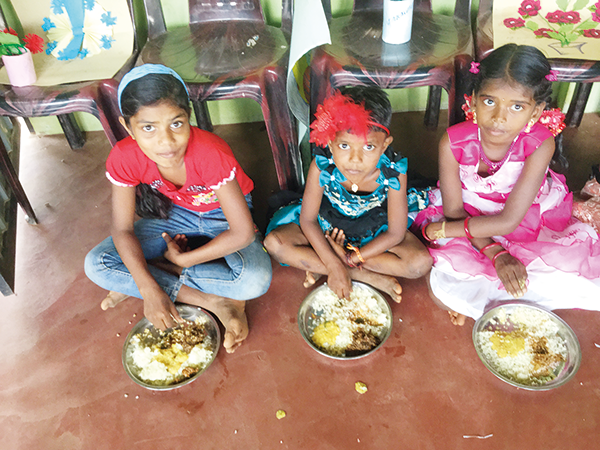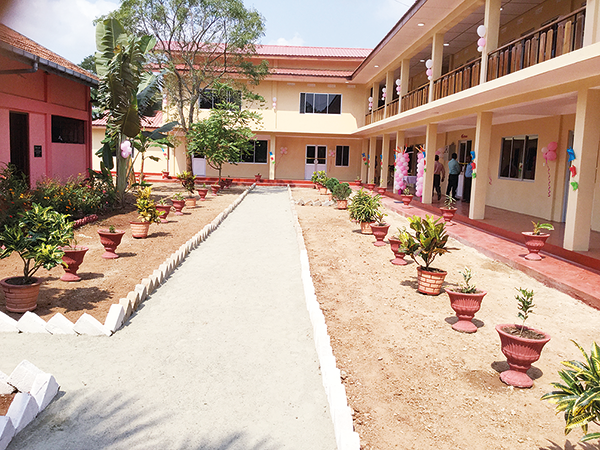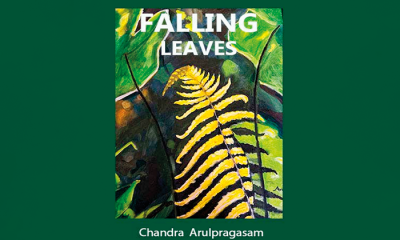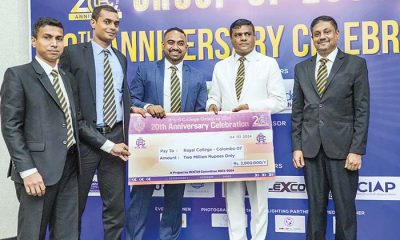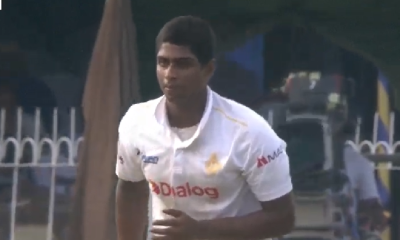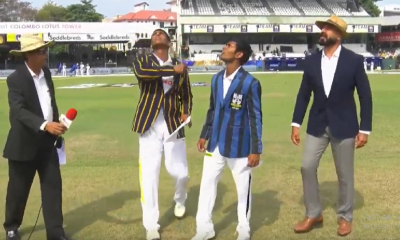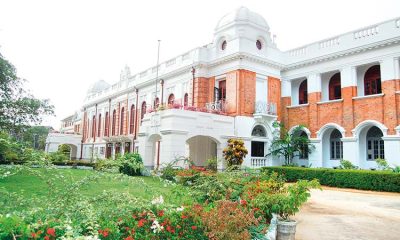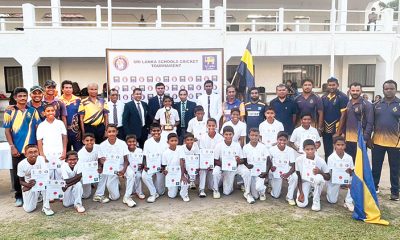Features
Benefactor who believes in helping them to help themselves
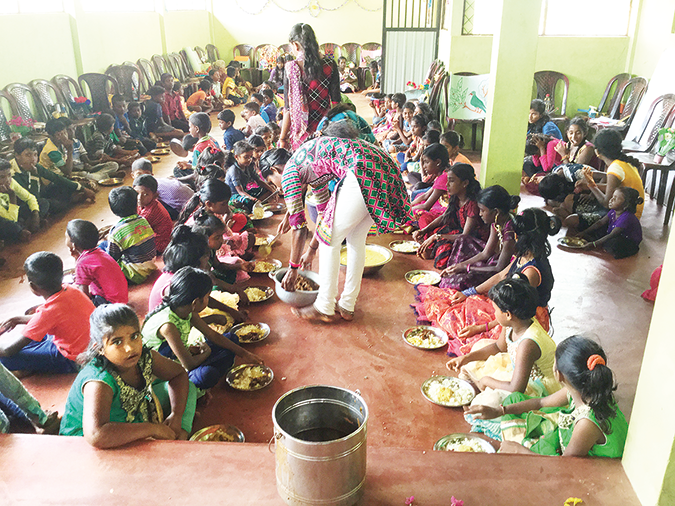
I cannot divulge the name of the humanitarian whose massive money  donation plus planning, personal time and effort have helped a central school and surrounding villages in the Vanni. He reluctantly consented to me writing about his project with the insisted upon proviso I do not name him nor drop clues to his identity. The aim of the article is not only to praise this person but to make wider known what can be done for our country by its nationals. Most important is the message he wants conveyed, which is given as conclusion to this article.
donation plus planning, personal time and effort have helped a central school and surrounding villages in the Vanni. He reluctantly consented to me writing about his project with the insisted upon proviso I do not name him nor drop clues to his identity. The aim of the article is not only to praise this person but to make wider known what can be done for our country by its nationals. Most important is the message he wants conveyed, which is given as conclusion to this article.
The Altruist
As a child and teenager, he moved around the island with his doctor father transferred from district to district, but was at Royal College, Colombo, throughout his secondary and senior secondary education. He then joined Colombo Medical College, passed out in 1964; served as a doctor here and then moved to London once he married and had a child. He built his career as a general practitioner under the NHS; felt he’d worked enough and took early retirement at age 66.
He had consistently visited Ceylon/ Sri Lanka, lengthening the holidays as his mother grew older. The visits did not cease with her death and the migration of all his siblings. He and his wife continued their holidays in the home country; he extending them for six months as the years passed. He came alone in 2020 and got enmeshed in the stay-put restrictions of the Covid pandemic. His wife and son were happy enough in London while he was the same in his own home in Borella, having plenty friends and even a scattering of relatives, with an excellent Woman Friday and faithful driver to see to his domestic and moving around needs.
The projects
During the extended Covid stay in Colombo, Dr W (let’s name him thus) met student day friends Mr Pancharatnam and Dr and Mrs Kasynathan of Point Pedro. They asked him whether he could help seven students of Mallavi Central College. That initial ‘yes’ ended by him pledging support for 15 students. He was invited by his friend to visit the school his beneficiary students attended. Agreed to. That was the first time in 2013 that he actually stood in front of the Central College, Mallavi, and its dilapidated buildings. He met the Principal, Mr T Jesuthanathar who updated him on urgent needs of the coeducational school and its pupils. Sister Gowsala conducted him within the girls’ hostel.
Dr W’s attention was focused on the girls’ hostel which housed around 30 and was far from adequate in space, amenities and all else. It needed urgent expansion and refurbishing. Though Mallavi itself was a growing township and improving, students of the Central College cycled to school each day from afar, often through deserted jungle areas; totally unsafe for girls. The boys managed the daily bicycle or walk to and from their homes or were boarded in local homes.
Dr W’s sterling pension from England was substantial; his child was now an employed professional and his wife lived comfortably over there. The family agreed he spend more time in Sri Lanka as was his wish, with him visiting London and his family spending holidays here.
The girls’ hostel had been repaired in 2013, but it still lacked necessary amenities and demand for hostel accommodation was pressing. So Dr W decided to build a new, spacious hostel building. Spending millions, with the cooperation of the principal and others, to the delight of Sister Gowsala, a spanking new two storey building rose up with rooms of residence, well equipped bathrooms and toilets, recreation halls and all else. Engineers in the district gave of their skills; labour was entirely local. It was ceremonially declared open in 2017. The girl’s hostel now houses 80 to 90 kids with classes in the school from Grade 6 to A/L. Excellent results at GCE OL and even AL exams proved how beneficial the money and cooperative effort put in to improve the school, and particularly the hostels, had been.
At present, with the assistance forthcoming from the Colombo Head of the Good Shepherd Nuns’ Order, two Sisters of that Order and a matron are in charge of the girls’ hostel, with a third Sister from the Claretion Catholic Order, paid for by Dr W. They are not mere supervisors but carers and counselors since students still suffer consequent strain of the civil war: sorrow of losing family members and continuing angst and imbued fear. Three women tackle the cooking of meals.
The boys had no hostel in the school. A request was acceded to and again Dr W paid for the construction of a building, completed in 2021, which now houses 30 boys. They enjoy their supervised stay; good meals; residence comforts compared to home restrictions; support for study, sports and games. One student recently told Dr W he wants to continue living in the hostel. “Impossible. Once you pass your ALs you have to leave.” “I shall stay on as warden!” was the reply.
Dr W subsidizes the monthly boarding fees of Rs 11,000 of all boarders – 110 as at present – by parents being charged Rs 7,000 per student and he paying the rest. When parents find they are able to pay just Rs 2,000 or 3,000, they are permitted, with Dr W chipping in the rest. He also pays the full fee for around 25 students. For him what is needed and contributed for is education for children and to ensure their happiness as far as possible through kind concern and generosity.
Dr W is not a mere money donor nor remote philanthropist. No, he even surpasses Bill Gates who stays over in African States when his donations immunize children, to supervise the programs. Dr W is streets ahead. He takes residence in a part of the boys’ hostel, almost monthly for at least four days; eats, chats and plays games with the boys and visits the girls’ domain.
Mallavi Central School is in five acres of land separated between the two hostels and the school proper by fences. The land is under cultivation of vegetables and fruit trees; and had a poultry farm and cattle shed with two gardeners, and students helping. The poultry project had to be reduced to rearing free ranging gan kukulas and kikilis due to the prohibitive rise in cost of chicken feed. Another increasing menace is marauding monkeys. Tall fences are climbed over. The hostels are self-sufficient in milk, eggs, veggies, coconut, fruits which include papaw, plantain in all its varieties, mango of the best yellow variety, and others. Seedlings taken from Colombo by Dr W and planted around the hostels are now fully grown and bearing fruit; 200 mango trees included.
Once the school was abundant in its garden produce, Dr W bought seedlings of coconut and fruit trees and distributed them in neighbouring villages; each costing on average Rs 2,500.
At about the same time he first went to the Mallavi Central College, Dr W visited a very poor village – Jeevanagal – in the District of Oddusuttan, also in the Vanni, where 110 families with 140 children live in poverty. They were displaced Indian labourers of the hill country due to estate riots in 1977, and were settled by the government in lands opened up by the Accelerated Mahaveli Development scheme. The local school – a government Vidyalayam – has primary to OL classes. It has restarted supplying the kids with a mid-day meal. However most stay on till their parents pick them up in the evening with teachers helping with their homework. Dr W supplies them afternoon tea or milk with a substantial snack; needless to say supplementing their nutriment intake and felt delight. On Saturdays they flock to the Day Centre he got built to enjoy a sumptuous rice and curry lunch, unfailingly with chicken or sprats and an egg each. A meal costs Rs 300 to 500. Dr W foots the entire bill.
Thus this Do Good Person is certainly not a mere donor but a staying-in benefactor, humanitarian, altruist, also a friendly father-figure in Mallavi. He benefits education, happy co-living and food security to the deprived.
Futuristic Opinion
Dr W preferred to name what he strongly feels about ‘a vision of hope’. He opines that most professionals who migrate to foreign lands for employment had their entire education from primary through secondary to university in Sri Lanka. Their free education expenses were then paid for by indirect tax payers: the tiller of the soil, cinnamon peeler, tea plucker, rubber tapper; More recently, in addition to the above, the garment factory worker, the tourism employee and those toiling overseas in menial jobs are the major money contributors to the government.
Thus to Dr W, justifiably, those Sri Lankans employed lucratively in developed countries, should consider contributing to Sri Lanka in cash or kind as almost mandatory – a return – gesture of gratitude; particularly now as the home country is mired in her worst economic crisis. Sending of dollars or pounds sterling is charitable, but the better way is to visit the home country and supervise how the donated money is utilized in whichever the chosen arena of assistance: whether it be in education, medical or any other field. Identifying a desperate family, donating a home and supporting just this one family is large enough an act of gratitude. Many expatriates do visit and give of their skill and money. More assistance is called for. I must mention that on reading the draft of this article, Dr W expressed horror, yes horror, that I had written much on the messenger but minimally on the message he wanted conveyed to other expat Sri Lankans. I subsequently better balanced the two but to me, the benefactor is of most interest and significance.
Features
The heart-friendly health minister

by Dr Gotabhya Ranasinghe
Senior Consultant Cardiologist
National Hospital Sri Lanka
When we sought a meeting with Hon Dr. Ramesh Pathirana, Minister of Health, he graciously cleared his busy schedule to accommodate us. Renowned for his attentive listening and deep understanding, Minister Pathirana is dedicated to advancing the health sector. His openness and transparency exemplify the qualities of an exemplary politician and minister.
Dr. Palitha Mahipala, the current Health Secretary, demonstrates both commendable enthusiasm and unwavering support. This combination of attributes makes him a highly compatible colleague for the esteemed Minister of Health.
Our discussion centered on a project that has been in the works for the past 30 years, one that no other minister had managed to advance.
Minister Pathirana, however, recognized the project’s significance and its potential to revolutionize care for heart patients.
The project involves the construction of a state-of-the-art facility at the premises of the National Hospital Colombo. The project’s location within the premises of the National Hospital underscores its importance and relevance to the healthcare infrastructure of the nation.
This facility will include a cardiology building and a tertiary care center, equipped with the latest technology to handle and treat all types of heart-related conditions and surgeries.
Securing funding was a major milestone for this initiative. Minister Pathirana successfully obtained approval for a $40 billion loan from the Asian Development Bank. With the funding in place, the foundation stone is scheduled to be laid in September this year, and construction will begin in January 2025.
This project guarantees a consistent and uninterrupted supply of stents and related medications for heart patients. As a result, patients will have timely access to essential medical supplies during their treatment and recovery. By securing these critical resources, the project aims to enhance patient outcomes, minimize treatment delays, and maintain the highest standards of cardiac care.
Upon its fruition, this monumental building will serve as a beacon of hope and healing, symbolizing the unwavering dedication to improving patient outcomes and fostering a healthier society.We anticipate a future marked by significant progress and positive outcomes in Sri Lanka’s cardiovascular treatment landscape within the foreseeable timeframe.
Features
A LOVING TRIBUTE TO JESUIT FR. ALOYSIUS PIERIS ON HIS 90th BIRTHDAY

by Fr. Emmanuel Fernando, OMI
Jesuit Fr. Aloysius Pieris (affectionately called Fr. Aloy) celebrated his 90th birthday on April 9, 2024 and I, as the editor of our Oblate Journal, THE MISSIONARY OBLATE had gone to press by that time. Immediately I decided to publish an article, appreciating the untiring selfless services he continues to offer for inter-Faith dialogue, the renewal of the Catholic Church, his concern for the poor and the suffering Sri Lankan masses and to me, the present writer.
It was in 1988, when I was appointed Director of the Oblate Scholastics at Ampitiya by the then Oblate Provincial Fr. Anselm Silva, that I came to know Fr. Aloy more closely. Knowing well his expertise in matters spiritual, theological, Indological and pastoral, and with the collaborative spirit of my companion-formators, our Oblate Scholastics were sent to Tulana, the Research and Encounter Centre, Kelaniya, of which he is the Founder-Director, for ‘exposure-programmes’ on matters spiritual, biblical, theological and pastoral. Some of these dimensions according to my view and that of my companion-formators, were not available at the National Seminary, Ampitiya.
Ever since that time, our Oblate formators/ accompaniers at the Oblate Scholasticate, Ampitiya , have continued to send our Oblate Scholastics to Tulana Centre for deepening their insights and convictions regarding matters needed to serve the people in today’s context. Fr. Aloy also had tried very enthusiastically with the Oblate team headed by Frs. Oswald Firth and Clement Waidyasekara to begin a Theologate, directed by the Religious Congregations in Sri Lanka, for the contextual formation/ accompaniment of their members. It should very well be a desired goal of the Leaders / Provincials of the Religious Congregations.
Besides being a formator/accompanier at the Oblate Scholasticate, I was entrusted also with the task of editing and publishing our Oblate journal, ‘The Missionary Oblate’. To maintain the quality of the journal I continue to depend on Fr. Aloy for his thought-provoking and stimulating articles on Biblical Spirituality, Biblical Theology and Ecclesiology. I am very grateful to him for his generous assistance. Of late, his writings on renewal of the Church, initiated by Pope St. John XX111 and continued by Pope Francis through the Synodal path, published in our Oblate journal, enable our readers to focus their attention also on the needed renewal in the Catholic Church in Sri Lanka. Fr. Aloy appreciated very much the Synodal path adopted by the Jesuit Pope Francis for the renewal of the Church, rooted very much on prayerful discernment. In my Religious and presbyteral life, Fr.Aloy continues to be my spiritual animator / guide and ongoing formator / acccompanier.
Fr. Aloysius Pieris, BA Hons (Lond), LPh (SHC, India), STL (PFT, Naples), PhD (SLU/VC), ThD (Tilburg), D.Ltt (KU), has been one of the eminent Asian theologians well recognized internationally and one who has lectured and held visiting chairs in many universities both in the West and in the East. Many members of Religious Congregations from Asian countries have benefited from his lectures and guidance in the East Asian Pastoral Institute (EAPI) in Manila, Philippines. He had been a Theologian consulted by the Federation of Asian Bishops’ Conferences for many years. During his professorship at the Gregorian University in Rome, he was called to be a member of a special group of advisers on other religions consulted by Pope Paul VI.
Fr. Aloy is the author of more than 30 books and well over 500 Research Papers. Some of his books and articles have been translated and published in several countries. Among those books, one can find the following: 1) The Genesis of an Asian Theology of Liberation (An Autobiographical Excursus on the Art of Theologising in Asia, 2) An Asian Theology of Liberation, 3) Providential Timeliness of Vatican 11 (a long-overdue halt to a scandalous millennium, 4) Give Vatican 11 a chance, 5) Leadership in the Church, 6) Relishing our faith in working for justice (Themes for study and discussion), 7) A Message meant mainly, not exclusively for Jesuits (Background information necessary for helping Francis renew the Church), 8) Lent in Lanka (Reflections and Resolutions, 9) Love meets wisdom (A Christian Experience of Buddhism, 10) Fire and Water 11) God’s Reign for God’s poor, 12) Our Unhiddden Agenda (How we Jesuits work, pray and form our men). He is also the Editor of two journals, Vagdevi, Journal of Religious Reflection and Dialogue, New Series.
Fr. Aloy has a BA in Pali and Sanskrit from the University of London and a Ph.D in Buddhist Philosophy from the University of Sri Lankan, Vidyodaya Campus. On Nov. 23, 2019, he was awarded the prestigious honorary Doctorate of Literature (D.Litt) by the Chancellor of the University of Kelaniya, the Most Venerable Welamitiyawe Dharmakirthi Sri Kusala Dhamma Thera.
Fr. Aloy continues to be a promoter of Gospel values and virtues. Justice as a constitutive dimension of love and social concern for the downtrodden masses are very much noted in his life and work. He had very much appreciated the commitment of the late Fr. Joseph (Joe) Fernando, the National Director of the Social and Economic Centre (SEDEC) for the poor.
In Sri Lanka, a few religious Congregations – the Good Shepherd Sisters, the Christian Brothers, the Marist Brothers and the Oblates – have invited him to animate their members especially during their Provincial Congresses, Chapters and International Conferences. The mainline Christian Churches also have sought his advice and followed his seminars. I, for one, regret very much, that the Sri Lankan authorities of the Catholic Church –today’s Hierarchy—- have not sought Fr.
Aloy’s expertise for the renewal of the Catholic Church in Sri Lanka and thus have not benefited from the immense store of wisdom and insight that he can offer to our local Church while the Sri Lankan bishops who governed the Catholic church in the immediate aftermath of the Second Vatican Council (Edmund Fernando OMI, Anthony de Saram, Leo Nanayakkara OSB, Frank Marcus Fernando, Paul Perera,) visited him and consulted him on many matters. Among the Tamil Bishops, Bishop Rayappu Joseph was keeping close contact with him and Bishop J. Deogupillai hosted him and his team visiting him after the horrible Black July massacre of Tamils.
Features
A fairy tale, success or debacle

Sri Lanka-Singapore Free Trade Agreement
By Gomi Senadhira
senadhiragomi@gmail.com
“You might tell fairy tales, but the progress of a country cannot be achieved through such narratives. A country cannot be developed by making false promises. The country moved backward because of the electoral promises made by political parties throughout time. We have witnessed that the ultimate result of this is the country becoming bankrupt. Unfortunately, many segments of the population have not come to realize this yet.” – President Ranil Wickremesinghe, 2024 Budget speech
Any Sri Lankan would agree with the above words of President Wickremesinghe on the false promises our politicians and officials make and the fairy tales they narrate which bankrupted this country. So, to understand this, let’s look at one such fairy tale with lots of false promises; Ranil Wickremesinghe’s greatest achievement in the area of international trade and investment promotion during the Yahapalana period, Sri Lanka-Singapore Free Trade Agreement (SLSFTA).
It is appropriate and timely to do it now as Finance Minister Wickremesinghe has just presented to parliament a bill on the National Policy on Economic Transformation which includes the establishment of an Office for International Trade and the Sri Lanka Institute of Economics and International Trade.
Was SLSFTA a “Cleverly negotiated Free Trade Agreement” as stated by the (former) Minister of Development Strategies and International Trade Malik Samarawickrama during the Parliamentary Debate on the SLSFTA in July 2018, or a colossal blunder covered up with lies, false promises, and fairy tales? After SLSFTA was signed there were a number of fairy tales published on this agreement by the Ministry of Development Strategies and International, Institute of Policy Studies, and others.
However, for this article, I would like to limit my comments to the speech by Minister Samarawickrama during the Parliamentary Debate, and the two most important areas in the agreement which were covered up with lies, fairy tales, and false promises, namely: revenue loss for Sri Lanka and Investment from Singapore. On the other important area, “Waste products dumping” I do not want to comment here as I have written extensively on the issue.
1. The revenue loss
During the Parliamentary Debate in July 2018, Minister Samarawickrama stated “…. let me reiterate that this FTA with Singapore has been very cleverly negotiated by us…. The liberalisation programme under this FTA has been carefully designed to have the least impact on domestic industry and revenue collection. We have included all revenue sensitive items in the negative list of items which will not be subject to removal of tariff. Therefore, 97.8% revenue from Customs duty is protected. Our tariff liberalisation will take place over a period of 12-15 years! In fact, the revenue earned through tariffs on goods imported from Singapore last year was Rs. 35 billion.
The revenue loss for over the next 15 years due to the FTA is only Rs. 733 million– which when annualised, on average, is just Rs. 51 million. That is just 0.14% per year! So anyone who claims the Singapore FTA causes revenue loss to the Government cannot do basic arithmetic! Mr. Speaker, in conclusion, I call on my fellow members of this House – don’t mislead the public with baseless criticism that is not grounded in facts. Don’t look at petty politics and use these issues for your own political survival.”
I was surprised to read the minister’s speech because an article published in January 2018 in “The Straits Times“, based on information released by the Singaporean Negotiators stated, “…. With the FTA, tariff savings for Singapore exports are estimated to hit $10 million annually“.
As the annual tariff savings (that is the revenue loss for Sri Lanka) calculated by the Singaporean Negotiators, Singaporean $ 10 million (Sri Lankan rupees 1,200 million in 2018) was way above the rupees’ 733 million revenue loss for 15 years estimated by the Sri Lankan negotiators, it was clear to any observer that one of the parties to the agreement had not done the basic arithmetic!
Six years later, according to a report published by “The Morning” newspaper, speaking at the Committee on Public Finance (COPF) on 7th May 2024, Mr Samarawickrama’s chief trade negotiator K.J. Weerasinghehad had admitted “…. that forecasted revenue loss for the Government of Sri Lanka through the Singapore FTA is Rs. 450 million in 2023 and Rs. 1.3 billion in 2024.”
If these numbers are correct, as tariff liberalisation under the SLSFTA has just started, we will pass Rs 2 billion very soon. Then, the question is how Sri Lanka’s trade negotiators made such a colossal blunder. Didn’t they do their basic arithmetic? If they didn’t know how to do basic arithmetic they should have at least done their basic readings. For example, the headline of the article published in The Straits Times in January 2018 was “Singapore, Sri Lanka sign FTA, annual savings of $10m expected”.
Anyway, as Sri Lanka’s chief negotiator reiterated at the COPF meeting that “…. since 99% of the tariffs in Singapore have zero rates of duty, Sri Lanka has agreed on 80% tariff liberalisation over a period of 15 years while expecting Singapore investments to address the imbalance in trade,” let’s turn towards investment.
Investment from Singapore
In July 2018, speaking during the Parliamentary Debate on the FTA this is what Minister Malik Samarawickrama stated on investment from Singapore, “Already, thanks to this FTA, in just the past two-and-a-half months since the agreement came into effect we have received a proposal from Singapore for investment amounting to $ 14.8 billion in an oil refinery for export of petroleum products. In addition, we have proposals for a steel manufacturing plant for exports ($ 1 billion investment), flour milling plant ($ 50 million), sugar refinery ($ 200 million). This adds up to more than $ 16.05 billion in the pipeline on these projects alone.
And all of these projects will create thousands of more jobs for our people. In principle approval has already been granted by the BOI and the investors are awaiting the release of land the environmental approvals to commence the project.
I request the Opposition and those with vested interests to change their narrow-minded thinking and join us to develop our country. We must always look at what is best for the whole community, not just the few who may oppose. We owe it to our people to courageously take decisions that will change their lives for the better.”
According to the media report I quoted earlier, speaking at the Committee on Public Finance (COPF) Chief Negotiator Weerasinghe has admitted that Sri Lanka was not happy with overall Singapore investments that have come in the past few years in return for the trade liberalisation under the Singapore-Sri Lanka Free Trade Agreement. He has added that between 2021 and 2023 the total investment from Singapore had been around $162 million!
What happened to those projects worth $16 billion negotiated, thanks to the SLSFTA, in just the two-and-a-half months after the agreement came into effect and approved by the BOI? I do not know about the steel manufacturing plant for exports ($ 1 billion investment), flour milling plant ($ 50 million) and sugar refinery ($ 200 million).
However, story of the multibillion-dollar investment in the Petroleum Refinery unfolded in a manner that would qualify it as the best fairy tale with false promises presented by our politicians and the officials, prior to 2019 elections.
Though many Sri Lankans got to know, through the media which repeatedly highlighted a plethora of issues surrounding the project and the questionable credentials of the Singaporean investor, the construction work on the Mirrijiwela Oil Refinery along with the cement factory began on the24th of March 2019 with a bang and Minister Ranil Wickremesinghe and his ministers along with the foreign and local dignitaries laid the foundation stones.
That was few months before the 2019 Presidential elections. Inaugurating the construction work Prime Minister Ranil Wickremesinghe said the projects will create thousands of job opportunities in the area and surrounding districts.
The oil refinery, which was to be built over 200 acres of land, with the capacity to refine 200,000 barrels of crude oil per day, was to generate US$7 billion of exports and create 1,500 direct and 3,000 indirect jobs. The construction of the refinery was to be completed in 44 months. Four years later, in August 2023 the Cabinet of Ministers approved the proposal presented by President Ranil Wickremesinghe to cancel the agreement with the investors of the refinery as the project has not been implemented! Can they explain to the country how much money was wasted to produce that fairy tale?
It is obvious that the President, ministers, and officials had made huge blunders and had deliberately misled the public and the parliament on the revenue loss and potential investment from SLSFTA with fairy tales and false promises.
As the president himself said, a country cannot be developed by making false promises or with fairy tales and these false promises and fairy tales had bankrupted the country. “Unfortunately, many segments of the population have not come to realize this yet”.
(The writer, a specialist and an activist on trade and development issues . )

